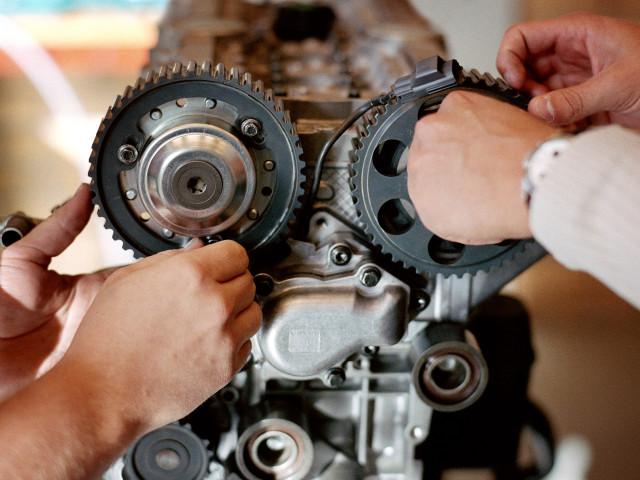SD1115 Fundamentals of Noise and Vibration Control 6.0 credits
This course has been discontinued.
Last planned examination: Spring 2020
Decision to discontinue this course:
No information inserted
Content and learning outcomes
Course contents
Theory: Fundamental concepts and measurement technique. The effects of noise and vibrations on humans and equipment. Mathematical methods. The wave equation and its solutions in fluids. Reflections, transmissions and standing waves. The wave equations and their solutions in solids. Energy methods and room acoustics. Sound generation and radiation. Vibration isolations. Sound in ducts. Measurement and analysis of sounds and vibrations.
Exercises: Theory-based calculations, above all in order to illuminate how this knowledge may be applied. Measurement exercise: 1. Measurement and analysis of vibrations. 2. Measurement and analysis of noise.
Intended learning outcomes
The course aims to provide the fundamentals of engineering noise and vibration – basic principles and phenomena, analysis methods and control techniques to engineer quieter and less-vibrating vehicles, machines, products, operations and environment.
By the end of this course, students should be able to identify and examine real noise and vibration issues in general; specify and analyse the sources and propagation of sound and vibration, define and evaluate alternative solutions and suggest measures to solve noise and vibration problems.
In detail, the students should be able to:
- Describe fundamental concepts of engineering noise and vibration, measurement techniques and instruments. Explain the effect of noise and vibrations on humans and equipment. Give an overview of the international standards, laws and regulations in the field.
- Apply their knowledge in mechanics to develop lumped mass models of continuous systems and derive corresponding equations of motion and, using knowledge in mathematics, mathematically represent and calculate solutions. Apply Fourier analysis to solve coupled differential equations, calculate the frequency content of periodic and transient signals and implement this knowledge to analyse mechanical systems. Describe methods to distinguish between linear and non-linear mechanical systems.
- Describe the physical foundations of mathematical models of sound waves in fluids and solids, wave propagation, transmission and reflection. Calculate important parameters, such as wave speed in different media and natural frequencies and modes for enclosures and solid structures. Describe different mechanisms of structural damping, suggest and implement suitable experimental methods to determine loss factor in structures.
- Explain the physical foundations of statistical room acoustics. Apply mathematical models and experimental methods to define sound propagation, transmission and interaction in rooms, compartments and cabins.
- Identify, describe and analyse physical phenomena that generate sound and vibration in mechanical systems; apply mathematical models to analyse sound and vibration generation.
- Explain the fundamental mechanisms of vibration isolation, apply different solutions and calculate design parameters.
- Explain different methods to control sound propagation in ducts; evaluate the need for sound attenuation and design mufflers for different applications.
Literature and preparations
Specific prerequisites
Basic courses in mathematics, mechanics, strength of materials, fluid mechanics, thermodynamics and electrical engineering.
Recommended prerequisites
Equipment
Literature
Bodén., Carlsson, U., Glav, R., Wallin, H.P., Åbom, M.: Ljud och vibrationer. Marcus Wallenberg Laboratoriet för Ljud- och Vibrationsforskning, Inst. för Farkostteknik, KTH, 2001. ISBN 91-7170-434-5 and a file with additional material.
Examination and completion
If the course is discontinued, students may request to be examined during the following two academic years.
Grading scale
Examination
- LAB1 - Measurement Course, 0.5 credits, grading scale: P, F
- TEN1 - Examination, 3.0 credits, grading scale: P, F
- TEN2 - Examination, 2.5 credits, grading scale: P, F
Based on recommendation from KTH’s coordinator for disabilities, the examiner will decide how to adapt an examination for students with documented disability.
The examiner may apply another examination format when re-examining individual students.
Other requirements for final grade
Written examination Theory (TEN1, 3 university credits), Calculations (TEN2, 2.5 university credits).
Approved lab. Exercises (LAB1, 0.5 university credits).
Opportunity to complete the requirements via supplementary examination
Opportunity to raise an approved grade via renewed examination
Examiner
Ethical approach
- All members of a group are responsible for the group's work.
- In any assessment, every student shall honestly disclose any help received and sources used.
- In an oral assessment, every student shall be able to present and answer questions about the entire assignment and solution.
Further information
Course room in Canvas
Offered by
Main field of study
Education cycle
Add-on studies
SD2125 Signals and Mechanical Systems
SD2140 Vibroacoustics
SD2165 Acoustical Measurements
SD2150 Experimental Structure Dynamics
SD2155 Flow Acoustics
SD1135 Project Course in Sound, Vibrations and Signals
SD2170 Energy Methods
SD2175 Numerical Methods for Acoustics and Vibration
SD2180 Non-Linear Acoustics
SD2185 Ultrasonics
SD2190 Vehicle Acoustics and Vibration